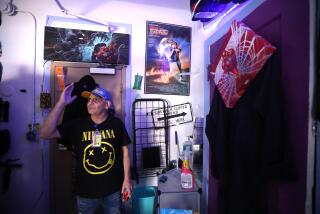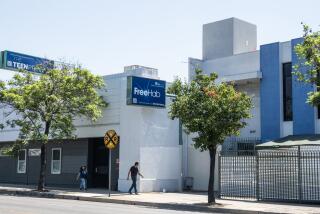Families Afflicted by HIV Find Haven
Margrette Chism explains to her children that sometimes things happen in this life you can’t control. That sometimes, you have to have endured the bad to appreciate the good.
After living in slum-like conditions in a single-room Long Beach apartment and then a homeless shelter, Chism, her husband and three children believe they have found something good, a home they can cherish while facing the difficulties of her HIV infection.
The Chisms live in Casa Alegria, a $9-million, village-style community of colorful townhomes in Silver Lake that had its grand opening Monday.
The Salvation Army-sponsored facility is reported to be one of the nation’s first and largest designed for homeless and low-income families affected by HIV/AIDS.
With architecturally attractive buildings in muted earth tones of tan, ocher, blue and green, lush landscaping and kid-friendly play areas, Casa Alegria seeks to provide a measure of care to a segment of the population that badly needs it.
It has had a huge impact on the lives of many of the 44 families who began arriving in June.
“It’s been amazing,” said Chism, 26, who lives in a three-bedroom, two-bath apartment with her husband, Derrick, a 9-year-old son and two daughters, 8 and 18 months. She was diagnosed with HIV nearly 10 years ago, but her husband and children are free of the virus. “There’s more space; everyone has their privacy. It’s quiet and secure. They couldn’t have built a better place for people like us.”
Providing families with a sense of security and comfort is a key goal of Casa Alegria, said Executive Director Douglas B. Loisel.
“A lot of the families we work with have been ostracized and excluded from other family members and from the larger community. They literally have no place to go,” said Loisel. “Here, people can stay with no stigma attached to the diagnosis.”
The facility on Sunset Boulevard is nearly four years in the making and is the culmination of strategies developed at Bethesda House, a Salvation Army-run facility opened in 1992 in downtown Los Angeles to meet some of the same housing and service needs of low-income people suffering with AIDS.
Bethesda House has closed, and many of its residents have moved into Casa Alegria, which can accommodate more families in a safer setting. The facility includes 16 units of one- and two-bedroom transitional housing for stays of up to two years and 28 units of two- and three-bedroom permanent housing.
Built with city, county, federal and private funds, the complex sets rent levels so that residents, who must be low-income earners, pay no more than 30% of their monthly income. Federal Section 8 housing vouchers can also be used to reduce rental costs.
There is a licensed 60-space day care center serving children of residents and families in the surrounding community. And services for those in transitional housing, who tend to be in less stable circumstances, include medical support, substance abuse treatment, vocational services, meals and medications.
Its backers say Casa Alegria and its programs are likely to become a model in helping to fill a shortage in services for the fastest-growing segment of the HIV/AIDS population in Los Angeles County: minorities, the poor and families.
“The thing about AIDS is that it doesn’t just impact the person infected, but the entire family,” said Anne Calvo, a registered nurse who is divisional health advisor for the Salvation Army and a former director of Bethesda House. “But I’ve seen dramatic changes in clients, who with housing and services, feel like they can regroup. Not having to worry about where you’re going to sleep or where your next meal is coming from makes a huge difference, emotionally and even physically.”
For Laverne Mack, Casa Alegria has meant finding extended family with whom she and her three sons can identify.
“My sons love it,” said Mack, 36, who was diagnosed with HIV in 1990. She is a single mother of two teenagers and an 18-month-old. “They’re not just around other kids their age they can play with, but kids who also have something in common.”
The boys have a secure place to hang out and play basketball in the enclosed courtyards and if she’s not around, other adults watch them, she said. Casa Alegria is developing after-school activities, and the families have had one beach outing.
“It’s been a tremendous difference in our lives,” said Mack, who before moving into Casa Alegria struggled to make ends meet while living in an overpriced two-bedroom Van Nuys apartment. “We feel like we’ve found a family here.”
More to Read
Sign up for Essential California
The most important California stories and recommendations in your inbox every morning.
You may occasionally receive promotional content from the Los Angeles Times.







